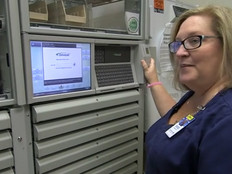Chicago Ideas Week 2016: ContextMedia Aims to Reshape the Waiting Room
Sitting in the waiting room of a doctor’s office can be a boring experience. Check email. Browse the web. Scan Facebook. Anything to pass the time. ContextMedia, a health information services company, wants to change that pattern of behavior, and is using a combination of technologies to transform the doctor-patient relationship.
ContextMedia will present its vision and technology at its Chicago headquarters on Wednesday as part of Chicago Ideas Week, in a session called “The Waiting Room of the Future.” Speaking at the event will be Philip de Guzman, ContextMedia’s communications lead; Jason Ketchum, the company’s senior director of promotional strategy; Matt Nolker, vice president of product experience; Ryan Postel, director of media; and Dham Pathervellai, vice president of engineering.
A Suite of Tech Solutions
Rishi Shah started ContextMedia in 2006, with a core idea of persuading doctors’ offices to install TVs in their waiting rooms that showed educational videos about medicines and medical issues instead of a random soap opera or news show. The firm now employs more than 360 people, has $63.5 million in revenue and grew thirtyfold from 2010 to 2015, according to Crain’s Chicago Business.
Since then, the firm’s solutions have grown to include digital waiting room screens to display content relevant to the patients in that office, as well as a mobility solution that gives patients access to complimentary Wi-Fi (which allows patients to opt in to relevant messaging from their physician). ContextMedia also offers tablets that patients can use to learn more about medical conditions.
Additionally, the firm offers an interactive wall-mounted display, which includes a physician mode that allows doctors to educate patients with detailed, 3D-responsive anatomical diagrams. Doctors can mark the diagrams to illustrate aspects of patient illness and educate on treatment options to improve retention.
The company says its technologies impact 378 million patient visits per year at 25,000 physician practices across the nation via these wall-sized displays, the tablets and mobile connectivity in outpatient waiting rooms, and physician consultation rooms.
Changing the Doctor-Patient Relationship
ContextMedia produces original content in addition to working with over 70 of the nation’s top associations and publishers, including the Academy of Nutrition and Dietetics, the Alzheimer's Association, the American Cancer Society, the American College of Gastroenterology, the American Diabetes Association, the American Lung Association and the Crohn’s & Colitis Foundation of America.
Patients spend an average of just under 30 minutes between the waiting room and seeing a doctor in the exam room, de Guzman says, and “we aim to make use of this time, and provide them with meaningful information in preparation for their conversation with their physician.
“Ideally, by the time they speak to their physician, they have already received actionable information to help manage their condition, and are prepared to have a meaningful dialogue,” he says. “That said, educational videos are only a small part of what we do, and we are building products that are increasingly interactive, and becoming a central component of the patient-physician consultation.”
ContextMedia’s solutions, de Guzman says, are designed to “give patients and physicians interactive digital solutions that they can use to have a better dialogue, and ultimately improve health outcomes.”
As an example, he pointed to the Digital Exam Room Wallboard, which he says was built to “address the needs of the engaged physician, who looks to use technology to better communicate conditions with their patients during the consultation itself.”
Instead of using photocopies, plastic models and posters are utilized to explain the condition and treatment options to patients, de Guzman says. Doctors can use the display to access dozens of 3D digital models in the exam room — at no cost — that they can rotate, annotate and share with patients. “This helps patients better comprehend their conditions, and ultimately better manage them,” he says.
A patient with a heart condition, for example, may need to have bypass surgery. In that case, the cardiologist could use interactive, 3D digital diagrams of the heart to walk the patient through the entirety of the procedure, de Guzman says. “The physician can rotate around the heart, zoom into other layers of the organ, and annotate the visualization,” he says. “Compare that with the practice that has existed for the past few decades: having a black and white printout of one point of view of the heart that is marked using a pen.”
Using Display and Cloud Technology
Last year, ContextMedia started custom manufacturing its own products. “We became the largest purchaser of large-format tablets in the world,” Shah told Crain’s. “We chose capacitive-touch technology, the same thing you find in an iPad. You might see some in a TV studio, but no one’s buying 50,000 of them. We purchased 100 late last year as a test, then decided to make our own using a contract manufacturer.”
This allowed the firm’s supply chain team to keep up with the demand for its products, while also driving costs down. It also gave ContextMedia’s product team end-to-end ownership over the design of its products, allowing the company to “ensure that we are building digital solutions that sincerely drive value for our partners, our member practices, and most importantly, our patients,” de Guzman notes.
All of the firm’s products need constant internet network access for device control and frequent content updates. ContextMedia’s products use a “heartbeat model” to communicate back to its cloud-hosted device platform, then report on device status as well as initiate scheduled content downloads. The products “are designed to work within the most constrained network environments and do not stream content from the internet — content is loaded locally to minimize bandwidth usage,” he says.
So where does ContextMedia go from here? de Guzman says the company wants to continue to grow rapidly and have a presence in 70 percent of all physician practices in the United States by 2020.









